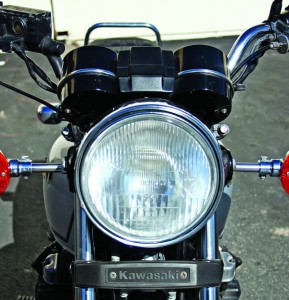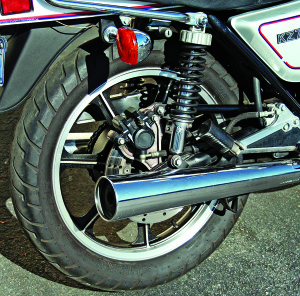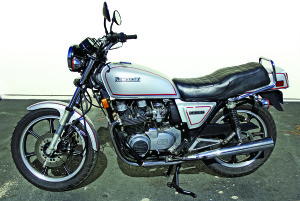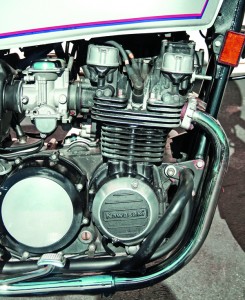How To Change The Chain On A Dual Overhead Cam On A 07 300 Kawasaki Mororcycle
(This Retrospective commodity was featured in the July 2012 issue of Rider Magazine)
Story and photography by Cloudless Salvadori
Year/Model: 1981 Kawasaki KZ750-East
Owner: Franco Teti, Los Osos, California
Class distinctions past engine size are of import, and are often delineated by the numbers on a motorcycle'southward side covers.
Advertisement
In 1980 the Universal Japanese Motorcycle (UJM) blueprint, with an air-cooled, overhead cam, in-line 4 engine, was pretty much running the industry, and while the departure betwixt a Honda 350/4 and a Yamaha 1100/4 was quite obvious, sometimes the differences were more than subtle.
Kawasaki had never been one to follow the crowd. When Honda came out with the '69 CB750, Ben Inamura, the head engineer at Kawasaki, focused on the 900cc Z-1, which appeared 3 years later. And and so he developed the KZ650/iv, with a bore and stroke of 62 by 54mm, for 652cc total. It was intended to have the treatment of a 500, the power of a 750…and at less than two grand, exist 10 percent cheaper than whatever 750/4. While toll might not have meant much to the BMW and Harley enthusiasts, it certainly did in the Japanese trade.
The 650 worked for a couple of years, with the aftermarket helping things along by offer all sorts of hop-upwardly equipment. But past 1979 the 750 class was by far the most popular, and 100cc was a lot to requite away, so Inamura decided that he was going to accept to get 750. This was to be no big redesign—no 16-valve heads, no new chassis—the KZ750 would simply be a bigger, meliorate KZ650.

Just to analyze things, in 1980 Kawasaki had ii very unlike KZ750s—the KZ750-K parallel twin, the engine of which had been on the market place since 1976 (Retrospective, December 1996), and the new in-line four, known past the postfix E.
Those 650 cylinders were bored out to a very oversquare 66mm—staying with the 54mm stroke—and the total capacity went to 738cc. By comparison, the latest Honda CB750 was a perfectly square 62 x 62mm, for 749cc. But the big news, or not news, was that Kawasaki was nevertheless using the old two-valve heads similar those on the 650—and these located their shims beneath the cam followers, which meant taking out the camshafts in order to suit the gaps. This was no big bargain if you knew what you were doing, but a lot of riders elected to take professional person mechanics do the job. Changes to the heads included one-millimeter larger exhaust valves, and little anti-smog vents to continue the EPAcrats at bay. This minimalist fob allowed oxygen to catamenia into the combustion sleeping accommodation and mix with any unexploded hydrocarbons, creating carbon dioxide that was on the approved list of emissions.

This anti-pollutant gizmo did not seem to harm performance. The KZ650 knocked out shut to 50 horsepower, and adding less than 90cc made the dynamometer evidence more than sixty horses at the rear wheel, with peak ponies coming at 9,500 rpm. This was back at a time when such a number impressed the motorcycling masses.
The major changes, other than the diameter-out, were the
bolting on of 34mm Keihin abiding-velocity carburetors, and the utilize of a transistorized ignition. An interesting tidbit is that this new four-banger was first introduced in Due south Africa, a relatively small market, merely obviously with the intent of allowing the bike to be consumer-tested before releasing it to the United States and Europe. Letting the average rider beat up a new motorcycle is a very good way of determining its potential, as Joe Bloke tin conceive of abuse that test riders might not. Apparently the bike held up well, as it was soon released to the residuum of the world.

Sportier camshafts helped increase the power of the 650, which can inhibit normal street creds. Merely not hither, as careful fiddling kept the torque max at the 7,500 rpm level, while sizably increasing the horsepower. Also undoubtedly a assist were these large CV carbs, 10mm bigger than the throttle-slides on the 650—though they were a thirsty lot. Mileage could be less than 40 mpg when ridden in a sprightly fashion, less than thirty when ridden difficult. If economy was on the rider'southward mind, he could purchase the KZ440 twin.
Principal drive was via a Hy-Vo chain between cylinders two and three; dorsum in those days this was considered an nugget since information technology evened out the strain on the crankshaft. The 650'due south clutch was used, with stiffer springs and minor revisions to the transmission, substantially strengthening the most-abused gears. And the final-bulldoze chain went from a 530 to a 630. Simply the total weight of the bicycle went down a couple of pounds…brilliant. Adjourn weight was a shade under 500 pounds.

The 650's frame was slightly revised to lower the saddle, only the big difference was in the suspension. An air-adjustable Kayaba fork provided almost half dozen inches of travel, with the firmness up to the passenger. Bending was 27 degrees, trail 4.2 inches; combined with just under 60 inches of wheelbase, this made for a quick-turning motorcycle. At the back, a pair of Kayaba shock absorbers came with tool-less preload aligning, using a big, grippable collar at the elevation; very handy. These allowed iv inches of axle travel. Test riders had minor complaints about the too-soft suspension, simply Kawasaki knew the majority of riders were more interested in comfort than those last 4 or 5 degrees of lean angle. And the racing-inclined could make their own modifications.
Cast wheels were protected past the new Dunlop Gold Seal tires; front end was a 100/90-xix, rear a 120/90-18. Triple 10.ii-inch discs with single-piston calipers provided acceptable stopping power. Once again, racers might complain, but the street rider definitely felt he had enough brake.
Throw a leg over the saddle and settle in. Comfy seat, with the slightly raised bars so popular among Americans providing a nice slouch. Ignition on, push the button and the two mufflers kept the noise muted. These were the same mufflers as found on the 650.

Once in gear, the clutch allowed a smooth getaway and a pleasant ride was alee. If you were headed for a elevate strip, a competent lightweight rider would see low 12s and over 100 mph in the quarter-mile, beating out (barely) the CB750F. But the prices of the 2 were now pretty equal, with the KZ at $2,750, the CB at $2,850. You pays your money and yous takes your pick.
Advertisement
Then, in 1982, Honda showed its brand-new VF750F, and a year subsequently Kawasaki's Ninja 900 appeared—shades of the CB750 vs. Z-1 900. Does history repeat itself?

Source: https://ridermagazine.com/2012/07/06/retrospective-kawasaki-kz750-e-1980-1982/
Posted by: spragueyoudiven.blogspot.com

0 Response to "How To Change The Chain On A Dual Overhead Cam On A 07 300 Kawasaki Mororcycle"
Post a Comment